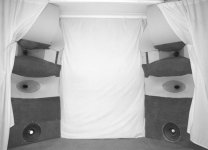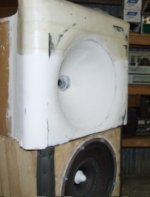I began this project aiming for better lower midrange.
I was having lunch at a club, and in the room was a drummer tapping a cymbal. I noticed I didn't have to think about it.. below 1kHz was there with the treble with the same acoustic sense. I don't get this from most speakers, there is a fatigue element in deciphering the inconsistent reflection pattern. A common problem is usually near and below the baffle step, as this is where most designs decide to allow the sound to go free.
I've long tried to bridge the gap so there is no baffle step. This is not easy, but when done right it comes with the benefit of consistency that eliminates the room in certain different ways.
Being in the corner has multiple advantages, as well as significant disadvantages that are difficult to overcome. Hence most speaker builders build for placement into the room... It allows the room to be used to aid in directivity that helps bridge the region where the most variation usually happens. It also offers the widest stereo separation available along a wall, as well as the longest early reflection delay times.
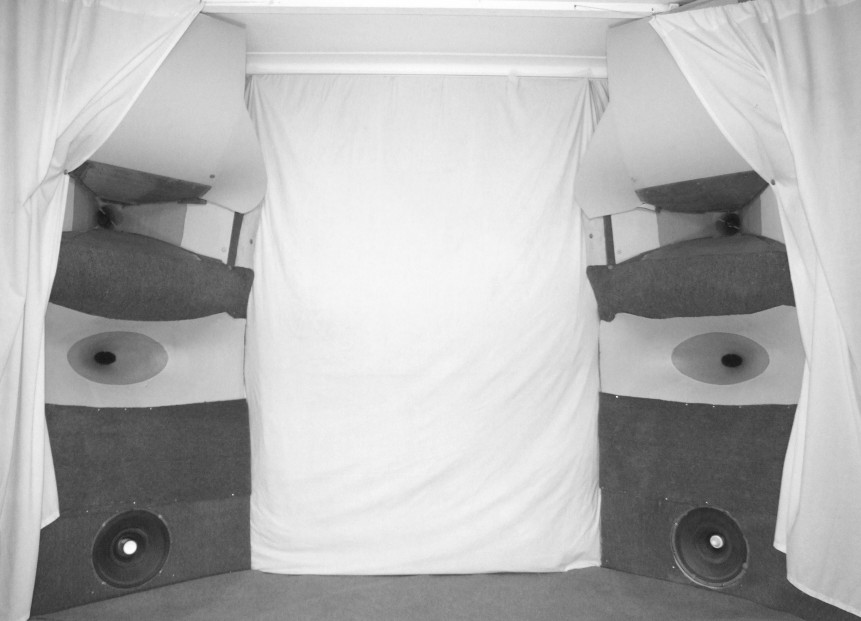
The B&C 8PE21 is efficient and suitable for horn loading.

Cymbals reach down to the low hundreds of Hz and are a good test IMO as the above and below 1kHz region needs to have no interruptions. I've had baffle region improvements in the past by adjusting the reflections with speaker position and EQ, with a lot of absorption. The sound was generally good and less fatiguing, but I wanted to take it further.
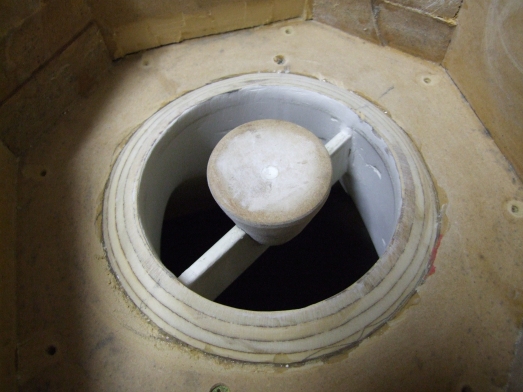
* Midrange phase plug
Corner placement has a later far side, and floor or ceiling reflection and can negate the other three walls. Stereo separation is increased and each speaker is toed in front of the listening position.
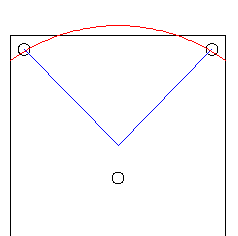
* The toe-in, and the approximate centre depth of the soundstage.
A multi-way system
I've been listening this way for about a year. At first the midrange would come from above the tweeter. Fixing the crossover blended them but the source sounded elongated. I damped some resonances in the mid horn walls and have also changed the vertical profile, now mono sound locates strictly between the tweeters.
Now I can walk up to it. The region away from the middle is silent.
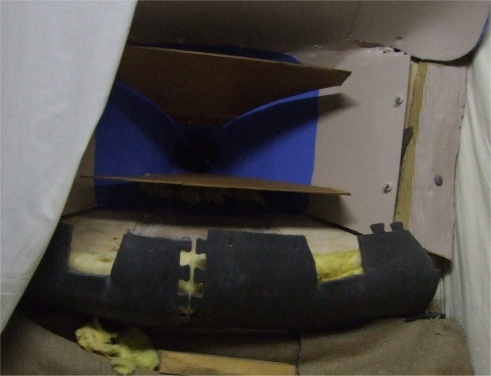
* Adjusting the midrange horn profile.
The rectangular cross-section on the mid horns helps at the room walls and makes them easier to build. They have a slow radius before offloading to the walls.
The tweeters are more narrow, and elliptical with a mouth radius before going back onto the wall.

I designed the tweeter horn to meet the mid at 700Hz. The vertical profile is narrower but longer, as both dimensions hold their directivity down to the same frequency. I then interpolated it to be ellipsoidal.
The woofer is baffled out of the corner but I want to push the woofer acoustic centre back. Behind the speakers and along the back wall has been lined with 100mm acoustic rockwool.
Tweeter
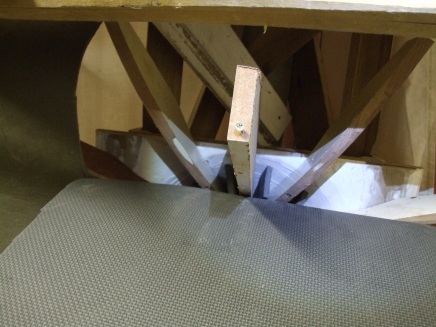
* Before using expanding foam.
The vertical profile is 45cm long, horizontal 30cm. The mouth width after the first roundovers is about 75cm around the ellipse. They are intended to be OS but I needed to interpolate some of the profile.
The tweeter and mid cross while around 80° H x 60° V.

* Rear view of the tweeter.
Acrylic (plexiglass) was used for the first 36mm. The next 20cm has a solid wooden outer layer with the profiles formed over this. At the start they are filled with plaster and further out by using ply and expanding foam. At the edges I'm using poly floor mats with rockwool packed behind them.
The driver is the B&C DE250.

Midrange
The horizontal profile is hyp-ex, and vertically they are T=0.8 LeCleach. Efficiency is around 107db/W/m.
The first part of the horn and the rear enclosure have been made from 36mm MDF. I used two 18mm sheets for this so I could have a constrained layer of PVA glue. The later parts of the horn use a plywood outer former with thin ply used for the profiles which I have filled with expanding foam.
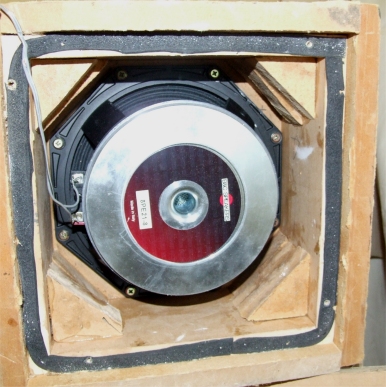
The B&C 8PE21 is well made. I'm using a compression ratio of 3:1.
Woofer
This direct radiator was a part of my old system and uses the Eminence Delta15 in a closed box. These are around 96dB sensitive and can be EQ'ed to any response I need.

* The cabinet uses CLD, hardwood bracing and flexible driver mounting.
The best crossover frequencies seem to be 270Hz and 800Hz.

* A random crossover measurement including tilting of the treble.
The midrange horn is spaced from the ceiling and is involved in two of the earliest reflections. This screenshot shows: Blue - One mid driver gated to exclude the ceiling reflection. Brown - The ceiling reflection. Green - The ceiling and floor. This was not taken at the listening position.

All drivers have an opposite side wall reflection after 8ms. With the woofer it seems to be affecting the response only above the crossover point.
Amplfication
Midrange and treble are amplified by a DIY JLH 10W/ch class A amp.

The bass drivers are separately amped for their sensitivity using a Philips 360.
I was having lunch at a club, and in the room was a drummer tapping a cymbal. I noticed I didn't have to think about it.. below 1kHz was there with the treble with the same acoustic sense. I don't get this from most speakers, there is a fatigue element in deciphering the inconsistent reflection pattern. A common problem is usually near and below the baffle step, as this is where most designs decide to allow the sound to go free.
I've long tried to bridge the gap so there is no baffle step. This is not easy, but when done right it comes with the benefit of consistency that eliminates the room in certain different ways.
Being in the corner has multiple advantages, as well as significant disadvantages that are difficult to overcome. Hence most speaker builders build for placement into the room... It allows the room to be used to aid in directivity that helps bridge the region where the most variation usually happens. It also offers the widest stereo separation available along a wall, as well as the longest early reflection delay times.
The B&C 8PE21 is efficient and suitable for horn loading.

Cymbals reach down to the low hundreds of Hz and are a good test IMO as the above and below 1kHz region needs to have no interruptions. I've had baffle region improvements in the past by adjusting the reflections with speaker position and EQ, with a lot of absorption. The sound was generally good and less fatiguing, but I wanted to take it further.

* Midrange phase plug
Corner placement has a later far side, and floor or ceiling reflection and can negate the other three walls. Stereo separation is increased and each speaker is toed in front of the listening position.

* The toe-in, and the approximate centre depth of the soundstage.
A multi-way system
I've been listening this way for about a year. At first the midrange would come from above the tweeter. Fixing the crossover blended them but the source sounded elongated. I damped some resonances in the mid horn walls and have also changed the vertical profile, now mono sound locates strictly between the tweeters.
Now I can walk up to it. The region away from the middle is silent.

* Adjusting the midrange horn profile.
The rectangular cross-section on the mid horns helps at the room walls and makes them easier to build. They have a slow radius before offloading to the walls.
The tweeters are more narrow, and elliptical with a mouth radius before going back onto the wall.

I designed the tweeter horn to meet the mid at 700Hz. The vertical profile is narrower but longer, as both dimensions hold their directivity down to the same frequency. I then interpolated it to be ellipsoidal.
The woofer is baffled out of the corner but I want to push the woofer acoustic centre back. Behind the speakers and along the back wall has been lined with 100mm acoustic rockwool.
Tweeter

* Before using expanding foam.
The vertical profile is 45cm long, horizontal 30cm. The mouth width after the first roundovers is about 75cm around the ellipse. They are intended to be OS but I needed to interpolate some of the profile.
The tweeter and mid cross while around 80° H x 60° V.

* Rear view of the tweeter.
Acrylic (plexiglass) was used for the first 36mm. The next 20cm has a solid wooden outer layer with the profiles formed over this. At the start they are filled with plaster and further out by using ply and expanding foam. At the edges I'm using poly floor mats with rockwool packed behind them.
The driver is the B&C DE250.

Midrange
The horizontal profile is hyp-ex, and vertically they are T=0.8 LeCleach. Efficiency is around 107db/W/m.
The first part of the horn and the rear enclosure have been made from 36mm MDF. I used two 18mm sheets for this so I could have a constrained layer of PVA glue. The later parts of the horn use a plywood outer former with thin ply used for the profiles which I have filled with expanding foam.

The B&C 8PE21 is well made. I'm using a compression ratio of 3:1.
Woofer
This direct radiator was a part of my old system and uses the Eminence Delta15 in a closed box. These are around 96dB sensitive and can be EQ'ed to any response I need.

* The cabinet uses CLD, hardwood bracing and flexible driver mounting.
The best crossover frequencies seem to be 270Hz and 800Hz.

* A random crossover measurement including tilting of the treble.
The midrange horn is spaced from the ceiling and is involved in two of the earliest reflections. This screenshot shows: Blue - One mid driver gated to exclude the ceiling reflection. Brown - The ceiling reflection. Green - The ceiling and floor. This was not taken at the listening position.

All drivers have an opposite side wall reflection after 8ms. With the woofer it seems to be affecting the response only above the crossover point.
Amplfication
Midrange and treble are amplified by a DIY JLH 10W/ch class A amp.

The bass drivers are separately amped for their sensitivity using a Philips 360.
Attachments
Last edited:
Very nice. I can tell by chosen crossover points that this system sounds great. Optimal range for that B&C mid driver.
This approach has been a favorite of mine for a long time. Honestly, I've never found any other loudspeaker type that can do what this configuration does. Kudos!
way cool in design and implementation ! - hey Wayne - does your flat-pack midhorn work well with the 8PE21?
Thanks for the comments.
Badman, I'll catch up with this soon. I'm also hoping to take measurements.
Badman, I'll catch up with this soon. I'm also hoping to take measurements.
Some Ideas for the Future
The B&C 8PE21 driver is capable of covering the entire speech range decade. [1] Setting c/o frequencies outside this range, avoids bifurcation of program content where the ears are most sensitive. To implement this coverage using a horn, a multi-slit phase plug must be used. [2] An example of this is addressed in the JBL Tech Note [3]
For bass, EV Pat 4 [4] bass horn with a PD1851 [5] would be a good acoustic match to what you already have.
References:
[1] 8PE21-FR
[2] AESP1384-1/4
[3] JBLTN-CMCD
[4] http://electrovoice.com/downloadfile.php?f=Patrician IV DIY Manual.pdf
[5] PD.1852
Regards,
WHG
The B&C 8PE21 driver is capable of covering the entire speech range decade. [1] Setting c/o frequencies outside this range, avoids bifurcation of program content where the ears are most sensitive. To implement this coverage using a horn, a multi-slit phase plug must be used. [2] An example of this is addressed in the JBL Tech Note [3]
For bass, EV Pat 4 [4] bass horn with a PD1851 [5] would be a good acoustic match to what you already have.
References:
[1] 8PE21-FR
[2] AESP1384-1/4
[3] JBLTN-CMCD
[4] http://electrovoice.com/downloadfile.php?f=Patrician IV DIY Manual.pdf
[5] PD.1852
Regards,
WHG
Attachments
This is where I combined the elliptical tweeter profile with the existing axis-symmetrical waveguide. I started with H & V.. four of the twelve pieces of formwork are just these.
The four at 30 degrees either side of the horizontal were made as a 50 percent compromise between H & V, and the other four are biased further toward the vertical.

Establishing the need for a phase plug.

First phase plug prototype (borderline performance)


The four at 30 degrees either side of the horizontal were made as a 50 percent compromise between H & V, and the other four are biased further toward the vertical.

Establishing the need for a phase plug.

First phase plug prototype (borderline performance)


Thank you Allen!
How many ways and which kind of transducers for each and why you made this choice?
How many ways and which kind of transducers for each and why you made this choice?
This is a 3 way, crossing at 700/300 (iirc). Including the multi-sub arrangement that makes 9 drivers. The tweeter is a B&C DE250, chosen because its phase plug allows good polars. Mid is B&C 8PE21, because it is efficient and has a strong motor for horn loading. The woofer is the Eminence Delta 15 i was using from my last speaker, with the treble section chopped off.
Attachments
Nice project!
In the end, you have the system running? With the speakers in corners?
What is the distance between speakers? How is the imaging, sound quality?
I have a square room (5 / 4.5m) and I was considering this kind of approach, speakers in corners.
Thanks!
In the end, you have the system running? With the speakers in corners?
What is the distance between speakers? How is the imaging, sound quality?
I have a square room (5 / 4.5m) and I was considering this kind of approach, speakers in corners.
Thanks!
The corners are 3.7m apart.
About imaging.. My focus here was towards no diffraction or early reflections, and directivity to be consistent. Imaging is about as good as it was intended to be. As an example, if I put these into mono, the sound appears to be coming from out in the yard through an imaginary window in the wall, and none originating inside the room, which shows how much the speakers are getting out of the way. I could walk up to that place and from left to right and this didn't change. I could have the sound up loud and go put my head in one of the horns and it was still silent.
Corner speakers can do so much with the space if the speakers are designed to use it. If they are not, they can conflict with the corners a lot more than if they were positioned out into the room.
About imaging.. My focus here was towards no diffraction or early reflections, and directivity to be consistent. Imaging is about as good as it was intended to be. As an example, if I put these into mono, the sound appears to be coming from out in the yard through an imaginary window in the wall, and none originating inside the room, which shows how much the speakers are getting out of the way. I could walk up to that place and from left to right and this didn't change. I could have the sound up loud and go put my head in one of the horns and it was still silent.
Corner speakers can do so much with the space if the speakers are designed to use it. If they are not, they can conflict with the corners a lot more than if they were positioned out into the room.
Thank you Allen!
How low do you run the Eminence?
The directivity target you had was 90*? It is maintened from 300hz up to which freq?
How low do you run the Eminence?
The directivity target you had was 90*? It is maintened from 300hz up to which freq?
Across the spectrum. If you're talking about the horizontal directivity, and allowing for small variations.. eg I designed the waveguide to be 80 degrees so I'd have room to keep the treble off the walls... Nominally it's 90 degrees all up.The directivity target you had was 90*? It is maintened from
Vertical it's a smooth flow too, from 60 at the top, down to where directivity doesn't make sense any more. Including through the crossover regions and where the woofer is mirrored in the floor.
It's cutting out in the 60-40Hz region, but the subs blend and take over.How low do you run the Eminence?
- Home
- Loudspeakers
- Multi-Way
- Build Thread: Corner Guided 3-Way
